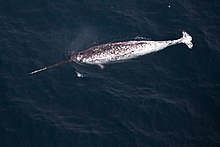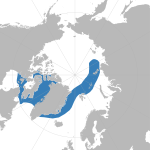
Back Narwal Afrikaans Monodon monoceros AN Nēohwæl ANG كركدن البحر Arabic حريش البحر ARZ Vwardol (Monodon monoceros) AVK Narval Azerbaijani Нарвал Byelorussian Нарвал BE-X-OLD Нарвал Bulgarian
| Narwhal | |
|---|---|

| |

| |
| Size compared to an average human | |
| Scientific classification | |
| Domain: | Eukaryota |
| Kingdom: | Animalia |
| Phylum: | Chordata |
| Class: | Mammalia |
| Order: | Artiodactyla |
| Infraorder: | Cetacea |
| Family: | Monodontidae |
| Genus: | Monodon Linnaeus, 1758 |
| Species: | M. monoceros
|
| Binomial name | |
| Monodon monoceros | |

| |
| Distribution of narwhal populations | |
The narwhal (Monodon monoceros) is a species of toothed whale native to the Arctic. It is the only member of the genus Monodon, and one of two living representatives of the family Monodontidae. The narwhal has a similar build to the closely related beluga whale, with which it overlaps in range and can interbreed. Shared characteristics include a pronounced melon, a short snout, and the absence of a true dorsal fin. The narwhal is sexually dimorphic; adult males are larger than females and have a single tusk that can be up to 3 m (9.8 ft) long. The tusk, which is derived from the left canine, is thought to serve as a weapon or as a tool for feeding, attracting mates or sensing water salinity. The jointed neck vertebrae and shallow dorsal ridge (rather than a dorsal fin) may facilitate movement under the ice, reduce surface area and heat loss, and allow a great range of manoeuvrability.
The narwhal inhabits Arctic waters of Canada, Greenland and Russia. Every year, it migrates to ice-free summering grounds, usually in shallow waters, and often returns to the same sites in subsequent years. Its diet mainly consists of polar and Arctic cod, Greenland halibut, cuttlefish, shrimp, and armhook squid. Plunging at depths of up to 2,370 m (7,780 ft), the narwhal is among the deepest-diving cetaceans. It travels in groups of five to ten, with aggregations of up to 1,000 occurring in the summer months. The narwhal mates in the offshore pack ice from March to May, and the young are born in July or August of the following year. When communicating, a variety of clicks, whistles and knocks are used.
There are an estimated 170,000 living narwhals, and the species is listed as being of least concern by the International Union for Conservation of Nature (IUCN). The population is threatened by the effects of climate change, such as the reduction in ice cover, and human activities such as pollution and hunting. The narwhal has been hunted for thousands of years by Inuit in northern Canada and Greenland for meat and ivory, and regulated subsistence hunts continue.
- ^ Newton, Edwin Tulley (1891). The Vertebrata of the Pliocene deposits of Britain. London: Her Majesty's Stationery Office. doi:10.5962/bhl.title.57425.
- ^ "Monodon monoceros Linnaeus 1758 (narhwal)". PBDB.org. Archived from the original on 12 July 2020. Retrieved 11 July 2020.
- ^ Lowry, L.; Laidre, K.; Reeves, R. (2017). "Monodon monoceros". IUCN Red List of Threatened Species. 2017. doi:10.2305/IUCN.UK.2017-3.RLTS.T13704A50367651.en.
- ^ "Appendices | CITES". cites.org. Archived from the original on 5 December 2017. Retrieved 14 January 2022.
© MMXXIII Rich X Search. We shall prevail. All rights reserved. Rich X Search
